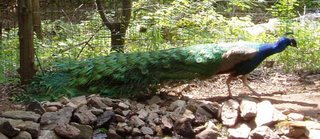Peacock Iridescence
 Wheeler Farms, in addition to a huge variety of alpine geraniums, has extensive and beautiful water gardens, interspersed with pathways, bridges, and tea houses. In one of the tea houses was an attractive vase full of peacock feathers, generously supplied, I assume, by this big fellow residing nearby. We heard him before we saw him--a peacock makes a sound like that of a large cat. Pretty creepy when you hear it issuing from the woods.
Wheeler Farms, in addition to a huge variety of alpine geraniums, has extensive and beautiful water gardens, interspersed with pathways, bridges, and tea houses. In one of the tea houses was an attractive vase full of peacock feathers, generously supplied, I assume, by this big fellow residing nearby. We heard him before we saw him--a peacock makes a sound like that of a large cat. Pretty creepy when you hear it issuing from the woods.Mr. Peacock's gorgeous colors are not produced by blue and green and gold pigments in his feathers--not primarily, anyway. They are produced by interference--waves of light interacting with each other. This phenomenon, known as iridescence, was noted by Sir Isaac Newton. Iridescent colors change as the viewing angle changes, since they are not inherent in the object.
Sister Leslie kept peacocks at the ranch in Arizona, and quite a number of years ago sent me a few lovely feathers. I still have them--at the moment they're fanned out in a Chinese vase that was my mother's, gracing a table in my parlor.
So...I've got the peacock feathers and the vase. Now all I need is the water garden and the tea house to complete my backyard tableau.


0 Comments:
Post a Comment
<< Home